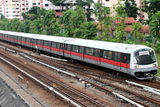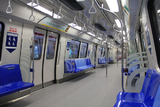Difference between revisions of "Kawasaki Heavy Industries & CSR Qingdao Sifang 151A"
m (→History) |
|||
| (24 intermediate revisions by 5 users not shown) | |||
| Line 1: | Line 1: | ||
{{Train | {{Infobox/Train | ||
|Name=Kawasaki Heavy Industries & CSR Qingdao Sifang | |Name=Kawasaki Heavy Industries & CSR Qingdao Sifang 151A | ||
| | |Img=[[File:C151A-Ext(1).png|center-left|160px]] [[File:C151A-Int(1).png|center-right|160px]] | ||
| | |Info1= | ||
| | {{Infoline|In service|2011 – Present}} | ||
{{ | {{Infoline|Manufacturer|Kawasaki Heavy Industries<br>CSR Qingdao Sifang}} | ||
{{ | {{Infoline|Origin|Qingdao, China}} | ||
{{ | {{Infoline|Constructed|2011 – 2014}} | ||
{{ | {{Infoline|Number Built|210 cars (35 Trains)}} | ||
{{ | |Info2= | ||
{{Infoline|Body Construction|Aluminium-alloy double-skinned construction}} | |||
{{Infoline|Length|23.83 m (DT)<br>22.8 m (M1/M2)}} | |||
{{Infoline|Width|3.2 m}} | |||
{{Infoline|Height|3.7 m}} | |||
{{Infoline|Doors|1.45 m, 8 per car}} | |||
| | {{Infoline|Maximum Speed|Design: 90 km/h<br>Service: 80 km/h}} | ||
{{ | {{Infoline|Traction Control|Fuji Electric IGBT-VVVF}} | ||
{{ | {{Infoline|Line Voltage|750V DC Third Rail}} | ||
{{ | {{Infoline|Track Gauge|1435 mm Standard Gauge}} | ||
{{ | |||
{{ | |||
{{ | |||
{{ | |||
{{ | |||
{{ | |||
}} | }} | ||
'''Kawasaki Heavy Industries & CSR Qingdao Sifang | '''Kawasaki Heavy Industries & CSR Qingdao Sifang 151A''' are the fourth generation of trains running on the {{NSL}} and the {{EWL}}. | ||
==History== | ==History== | ||
On May 6, 2009, the Land Transport Authority announced that Kawasaki Heavy Industries and CSR Qingdao Sifang had won over Hyundai Rotem, Bombardier Transportation and Mitsubishi Heavy Industries to secure the contract at a cost of S$369 million, despite Hyundai Rotem offering the lowest bid at S$323 million for the order of 22 trainsets. CSR Sifang handled the manufacturing and testing of the rolling stock, while Kawasaki oversaw the project and design. | On May 6, 2009, the Land Transport Authority announced that Kawasaki Heavy Industries and CSR Qingdao Sifang had won over Hyundai Rotem, Bombardier Transportation and Mitsubishi Heavy Industries to secure the contract at a cost of S$369 million, despite Hyundai Rotem offering the lowest bid at S$323 million for the order of 22 trainsets. CSR Sifang handled the manufacturing and testing of the rolling stock, while Kawasaki oversaw the project and design. Contract 151A was the first successful joint venture between these two companies in the international market.<ref>[//www.csrgc.com.cn/ens/xwzx/2009-05-13/1277.shtml "CSR Sifang and Kawasaki Heavy Industries Won the Bid in the Subway Vehicle Project of Singapore"]. 13 May 2009. Retrieved 8 Feb 2012.</ref> | ||
In 2013, a further order of 13 trainsets was placed and as of 2014, all 35 trainsets have been officially put into revenue service.<ref>[//www.khi.co.jp/news/detail/20120829_1.html "Both orders for Singapore Subway Train 132 LTA"]. 29 Aug 2012. Retrieved 5 Sep 2012.</ref> | |||
On 5 July 2016, an investigative news report from FactWire alleged that KSF(A) trainsets were being shipped back to Qingdao for rectification due to multiple defects, including an exploding battery and cracks on trains, but without notifying the public beforehand. The Land Transport Authority acknowledged the trains were returned for rectification works, and have since published official statements to address FactWire's specific allegations. | |||
=== | ==Design/Features== | ||
{| class="toccolours" border=1 style="text-align:center;" | |||
|-class="SMRT" | |||
!class="LTA"| | |||
!Initial | |||
|- | |||
! | |||
|<div class="train">{{TrainCar|DT|FF8CAA|left|000}} {{TrainCar|M1|6991E1||000}} {{TrainCar|M2|46BED7||000}} {{TrainCar|M2|46BED7||000}} {{TrainCar|M1|6991E1||000}} {{TrainCar|DT|FF8CAA|right|000}}</div> | |||
|-style="background-color:#DDD" | |||
!colspan=2|Exterior Design | |||
|- | |||
!style="text-align:left"|Livery | |||
|Black,Red,Grey (Top to bottom) | |||
|- | |||
!style="text-align:left"|Train Run Number | |||
|Yellow LED | |||
|-style="background-color:#DDD" | |||
!colspan=2|Interior Design | |||
|- | |||
!style="text-align:left"|Seating Capacity | |||
|292 | |||
|- | |||
!style="text-align:left"|Wheelchair Bay | |||
|2, 1 each at Third and Fourth Car | |||
|- | |||
!style="text-align:left"|Door Closing Indicator Lights | |||
|5 Red LED (Top) | |||
|- | |||
!style="text-align:left"|Passenger Information System | |||
|SMRT Active Route-map and Information System (Dynamic Route Map + VFD display) | |||
|-style="background-color:#DDD" | |||
!colspan=2|System | |||
|- | |||
!style="text-align:left"|Safety System | |||
|ATC, ATO, ATP, ATS | |||
|- | |||
!style="text-align:left"|Signalling System | |||
|<s style='color:#808080;'>Fixed-Block</s><br>Communication Based Train Control | |||
|- | |||
!style="text-align:left"|Traction Motor | |||
|IGBT-VVVF (Fuji Electric) | |||
|} | |||
== | ==Fleet Numbering== | ||
The car numbers of the trains range from x501 to x570, where x depends on the carriage type. | The car numbers of the trains range from x501 to x570, where x depends on the carriage type. | ||
*The first digit | *The first digit identifies the position of the car from the closest end of the train; where ‘3’ represents first car, ‘1’ represents second car and ‘2’ represents third car. | ||
* | **(Example) Passenger Vehicle 569/570 would consist of 6 cars with serial number 3569, 1569, 2569, 2570, 1570 and 3570 respectively. | ||
* | *Depending on the direction of travel, the sequence may be reversed. | ||
==References== | ==References== | ||
<references/> | <references/> | ||
{{Mass Rapid Transit}} | {{Mass Rapid Transit}} | ||
{{North–South Line}} | |||
{{East–West Line}} | |||
[[Category:Train Rolling Stock]] | [[Category:Train Rolling Stock]] | ||
Latest revision as of 08:27, 17 June 2023
Kawasaki Heavy Industries & CSR Qingdao Sifang 151A are the fourth generation of trains running on the North–South Line and the East–West Line.
History[edit]
On May 6, 2009, the Land Transport Authority announced that Kawasaki Heavy Industries and CSR Qingdao Sifang had won over Hyundai Rotem, Bombardier Transportation and Mitsubishi Heavy Industries to secure the contract at a cost of S$369 million, despite Hyundai Rotem offering the lowest bid at S$323 million for the order of 22 trainsets. CSR Sifang handled the manufacturing and testing of the rolling stock, while Kawasaki oversaw the project and design. Contract 151A was the first successful joint venture between these two companies in the international market.[1]
In 2013, a further order of 13 trainsets was placed and as of 2014, all 35 trainsets have been officially put into revenue service.[2]
On 5 July 2016, an investigative news report from FactWire alleged that KSF(A) trainsets were being shipped back to Qingdao for rectification due to multiple defects, including an exploding battery and cracks on trains, but without notifying the public beforehand. The Land Transport Authority acknowledged the trains were returned for rectification works, and have since published official statements to address FactWire's specific allegations.
Design/Features[edit]
| Initial | |
|---|---|
DT M1 M2 M2 M1 DT
| |
| Exterior Design | |
| Livery | Black,Red,Grey (Top to bottom) |
| Train Run Number | Yellow LED |
| Interior Design | |
| Seating Capacity | 292 |
| Wheelchair Bay | 2, 1 each at Third and Fourth Car |
| Door Closing Indicator Lights | 5 Red LED (Top) |
| Passenger Information System | SMRT Active Route-map and Information System (Dynamic Route Map + VFD display) |
| System | |
| Safety System | ATC, ATO, ATP, ATS |
| Signalling System | Communication Based Train Control |
| Traction Motor | IGBT-VVVF (Fuji Electric) |
Fleet Numbering[edit]
The car numbers of the trains range from x501 to x570, where x depends on the carriage type.
- The first digit identifies the position of the car from the closest end of the train; where ‘3’ represents first car, ‘1’ represents second car and ‘2’ represents third car.
- (Example) Passenger Vehicle 569/570 would consist of 6 cars with serial number 3569, 1569, 2569, 2570, 1570 and 3570 respectively.
- Depending on the direction of travel, the sequence may be reversed.
References[edit]
- ↑ "CSR Sifang and Kawasaki Heavy Industries Won the Bid in the Subway Vehicle Project of Singapore". 13 May 2009. Retrieved 8 Feb 2012.
- ↑ "Both orders for Singapore Subway Train 132 LTA". 29 Aug 2012. Retrieved 5 Sep 2012.
| [ V • T • E ] | ||
|---|---|---|
| Overview | History • Stations • Fare and Ticketing • Facilities • Safety • Security | |
| Lines | North–South Line • East–West Line • North East Line • Circle Line • Downtown Line • Thomson–East Coast Line | |
| FutureJurong Region Line • Cross Island Line | ||
| Rolling Stocks | 151 • 151A • 151B • 151C • R151 • T251 • 651 • 751A • 751B • 751C • 830 • 830C • 851E • 951 | |
| FutureJ151 • CR151 | ||
| Depots | Bishan • Changi • Gali Batu • Kim Chuan • Mandai • Sengkang • Ulu Pandan • Tuas | |
| FutureChangi East • East Coast • Tengah | ||
| [ V • T • E ] | ||
|---|---|---|
| Stations | Jurong East • Bukit Batok • Bukit Gombak • Choa Chu Kang • Yew Tee • Kranji • Marsiling • Woodlands • Admiralty • Sembawang • Canberra • Yishun • Khatib • Yio Chu Kang • Ang Mo Kio • Bishan • Braddell • Toa Payoh • Novena • Newton • Orchard • Somerset • Dhoby Ghaut • City Hall • Raffles Place • Marina Bay • Marina South Pier | |
| Rolling Stock | 151 • 651 • 751B • 151A • 151B • 151C • R151 | |
| Depots | Bishan • Ulu Pandan | |
| Others | Bridging Service | |
| [ V • T • E ] | ||
|---|---|---|
| Stations | Pasir Ris • Tampines • Simei • Tanah Merah • Bedok • Kembangan • Eunos • Paya Lebar • Aljunied • Kallang • Lavender • Bugis • City Hall • Raffles Place • Tanjong Pagar • Outram Park • Tiong Bahru • Redhill • Queenstown • Commonwealth • Buona Vista • Dover • Clementi • Jurong East • Chinese Garden • Lakeside • Boon Lay • Pioneer • Joo Koon • Gul Circle • Tuas Crescent • Tuas West Road • Tuas Link | |
| Changi Airport ExtensionTanah Merah • Expo • Changi Airport | ||
| Rolling Stock | 151 • 651 • 751B • 151A • 151B • 151C • R151 | |
| Depots | Changi • Ulu Pandan • Tuas • East Coast | |
| Others | Bridging Service | |

